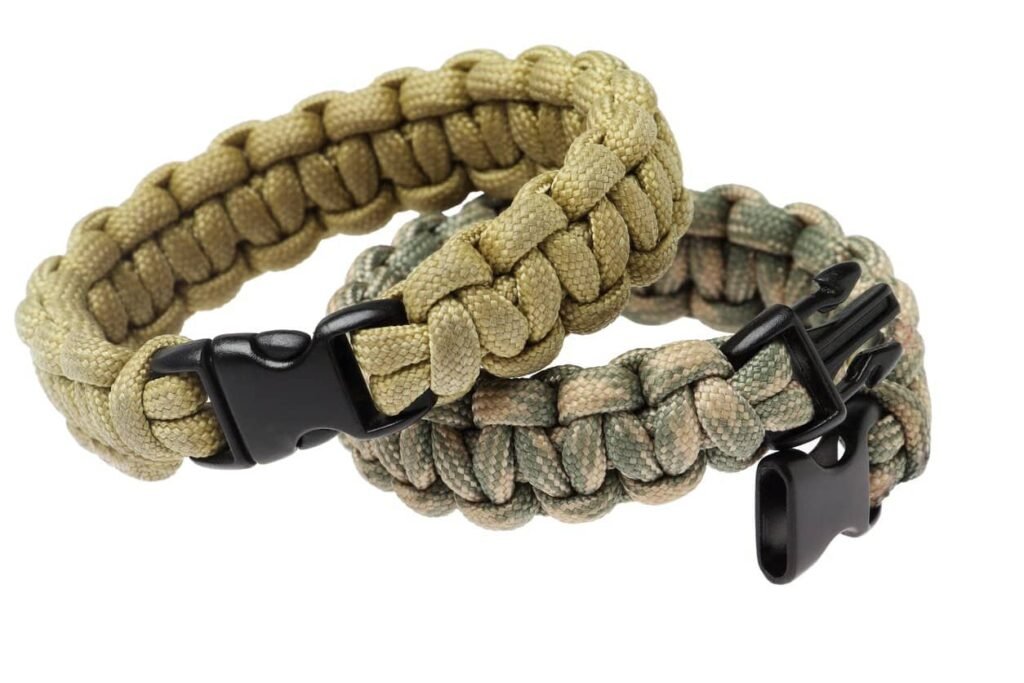
Welcome to the essential guide on maintaining your paracord bracelet. Paracord bracelets, renowned for their durability and versatility, are a staple in any outdoor enthusiast’s gear. However, regular use can expose them to dirt, sweat, and grime, affecting their appearance and longevity. This article offers a comprehensive approach to effectively cleaning your paracord bracelet, ensuring it remains a functional and stylish accessory. Whether you’re trekking through the wilderness or simply wearing it daily, learn how to keep your bracelet in pristine condition.
Understanding Paracord Material
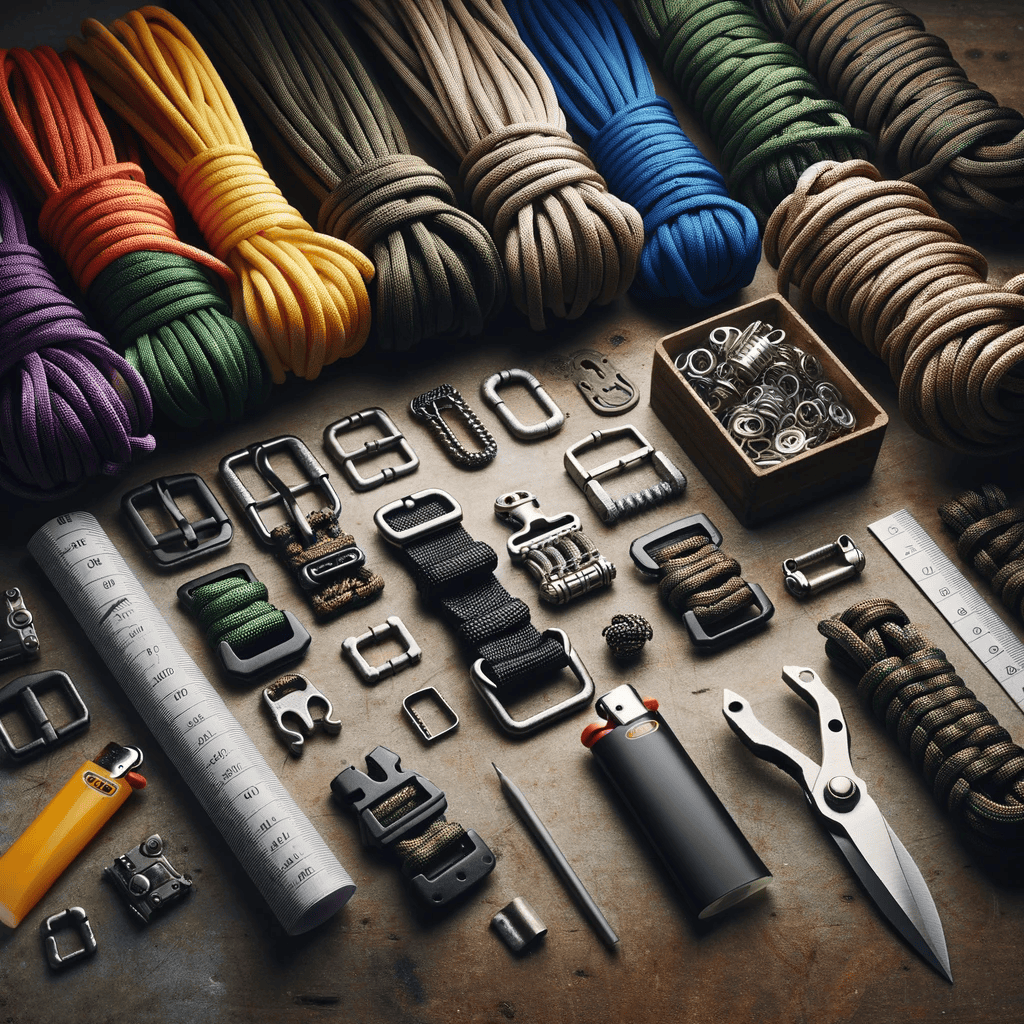
Different Types of Paracord
While Type III (550) paracord is most popular for bracelet making, other types like Type I (95 cord), Type II (425 cord), and Type IV (750 cord) are available, each with different strength and thickness. Understanding these variations is important for choosing the right cleaning approach.
Water Resistance and Quick Drying
Nylon, the primary material in paracord, is water-resistant and quick-drying, making it suitable for use in various environments. However, prolonged exposure to water and moisture can still lead to wear over time, so understanding proper drying techniques post-cleaning is essential.
Colorfastness and UV Resistance
Most high-quality paracords are colorfast, meaning they retain their color without bleeding during washing. However, continuous exposure to sunlight can cause the colors to fade over time. Special UV-resistant paracords are also available for those who frequently use their bracelets outdoors. UV Resistance in Paracord
Mildew Resistance
One of the advantages of nylon paracord is its resistance to mildew and rot, making it a durable option for outdoor use. However, storing it while damp or in humid conditions can still affect its longevity, emphasizing the importance of proper storage post-cleaning.
Pre-Cleaning Preparation for Paracord Bracelets
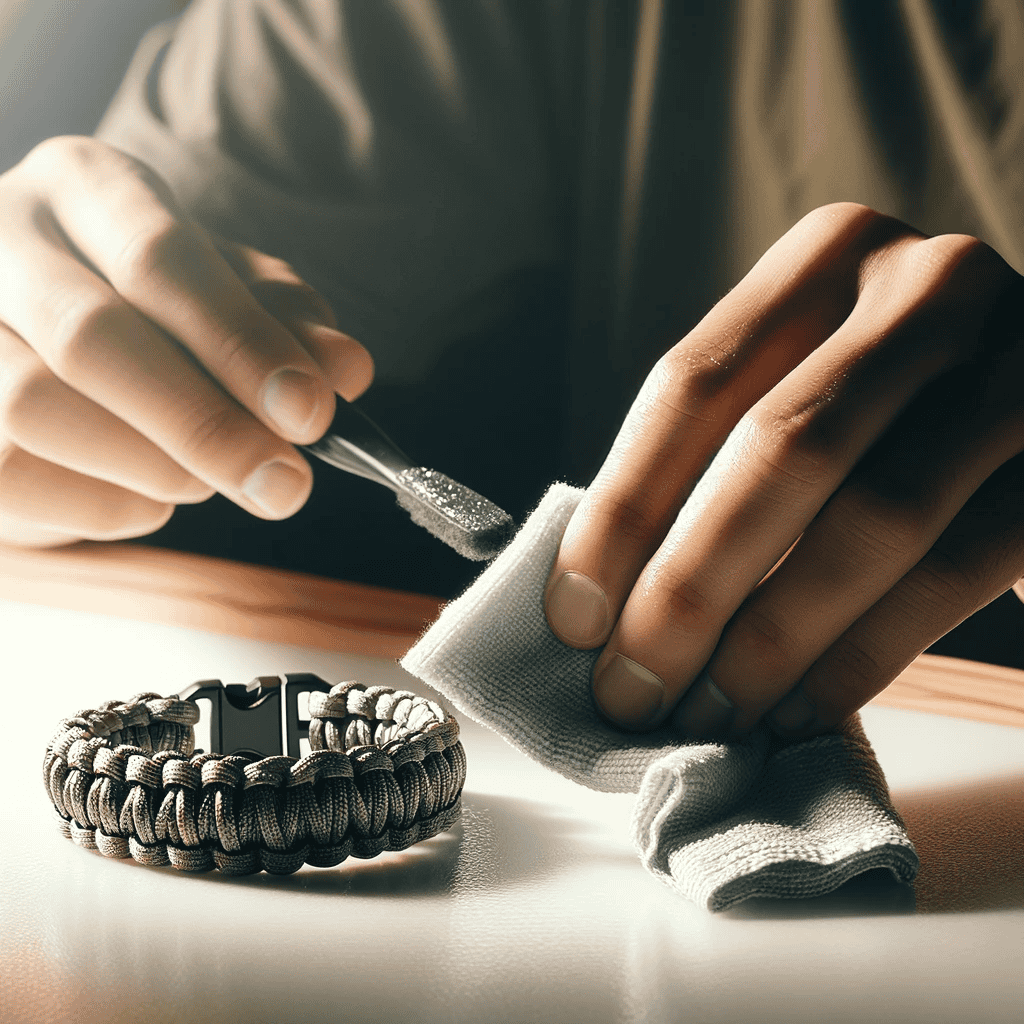
Inspecting the Bracelet
Begin by carefully inspecting the bracelet for any signs of wear, such as fraying or loose knots. Identifying areas that need repair before washing is crucial, as water exposure can exacerbate existing damage. Bracelet Inspection Tips
Removing Attachments
If your paracord bracelet includes metal attachments, like buckles, beads, or charms, consider removing them if possible. Water and cleaning agents can cause these elements to tarnish or corrode. For bracelets with non-removable metal parts, extra care should be taken to dry these components thoroughly after washing.
Pre-Treating Stains
For bracelets with noticeable stains, pre-treating them can make the cleaning process more effective. Apply a small amount of mild soap or a stain remover to the affected area and gently rub it in. Be cautious not to use harsh chemicals that could degrade the nylon fibers.
Untangling the Cord
Ensure that the paracord is free from tangles. Gently unravel any knots that aren’t part of the bracelet’s design. This will allow for more thorough cleaning, ensuring that all parts of the bracelet are properly exposed to the cleaning agent. Untangling Paracord Techniques
Choosing the Right Cleaning Agent
Select a mild soap or a specialized paracord cleaner that is gentle on nylon. Harsh detergents can strip the natural oils from the fibers, leading to increased wear and tear over time.
Testing Colorfastness
Before applying soap to the entire bracelet, test it on a small, inconspicuous area to ensure the color doesn’t bleed or fade. This step is particularly important for brightly colored or multi-colored paracord bracelets. Colorfastness Testing Method
Basic Cleaning Techniques for Paracord Bracelets
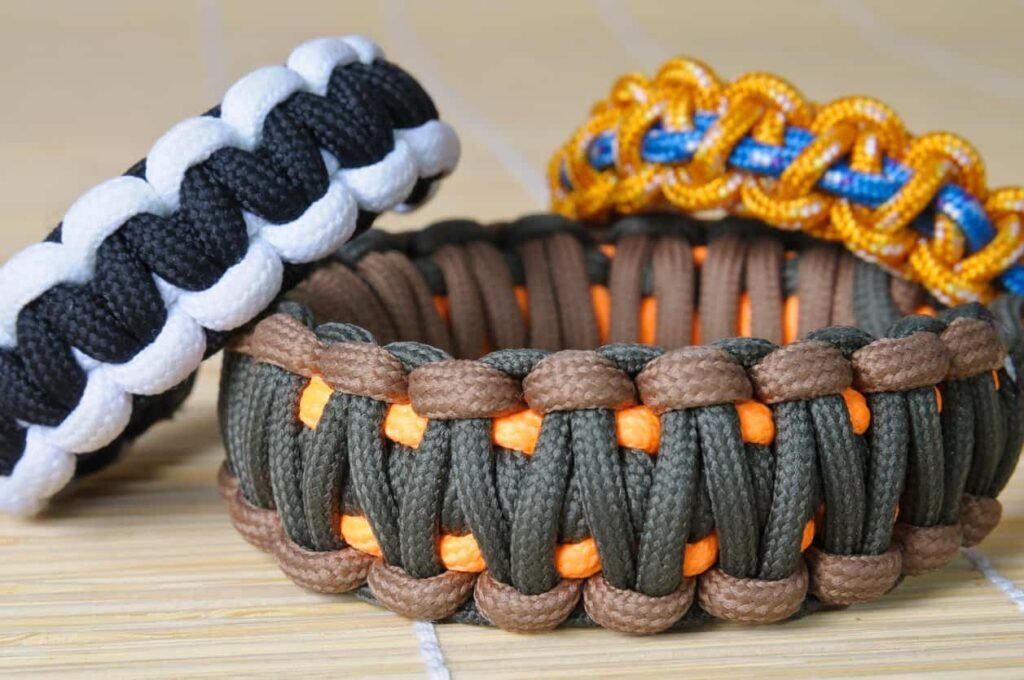
Hand Washing: The Preferred Method
Hand washing is the most recommended method for cleaning paracord bracelets, as it’s gentle and allows for targeted cleaning. Fill a basin with lukewarm water and add a small amount of mild soap. Submerge the bracelet and gently rub the cord to remove dirt and grime. Avoid using hot water, as it can weaken the nylon fibers. Hand Washing Paracord Bracelets
Using a Soft Brush for Stubborn Dirt
For bracelets with embedded dirt, use a soft-bristled brush, like a toothbrush, to gently scrub the affected areas. Be cautious not to scrub too hard, as this can cause fraying.
Rinsing Thoroughly
After washing, rinse the bracelet thoroughly under running water to remove all soap residues. Remaining soap can attract more dirt and may lead to skin irritation if not fully rinsed out.
Drying the Bracelet
Gently squeeze out excess water from the bracelet and lay it flat to air dry. Avoid wringing the bracelet, as this can distort its shape and weaken the cord. Do not use a dryer or expose the bracelet to direct heat sources, as high heat can damage the nylon. Air Drying Paracord
Spot Cleaning for Light Soiling
If your bracelet is only lightly soiled, spot cleaning might be sufficient. Apply a small amount of soap to the dirty area, gently rub, and rinse. This method is quick and effective for minor cleaning needs.
Avoiding Harsh Chemicals
Never use bleach or other harsh chemicals on paracord bracelets, as they can degrade the nylon material and cause color fading. Always opt for mild soaps or detergents. Chemical Safety for Paracord
Removing Tough Stains from Paracord Bracelets
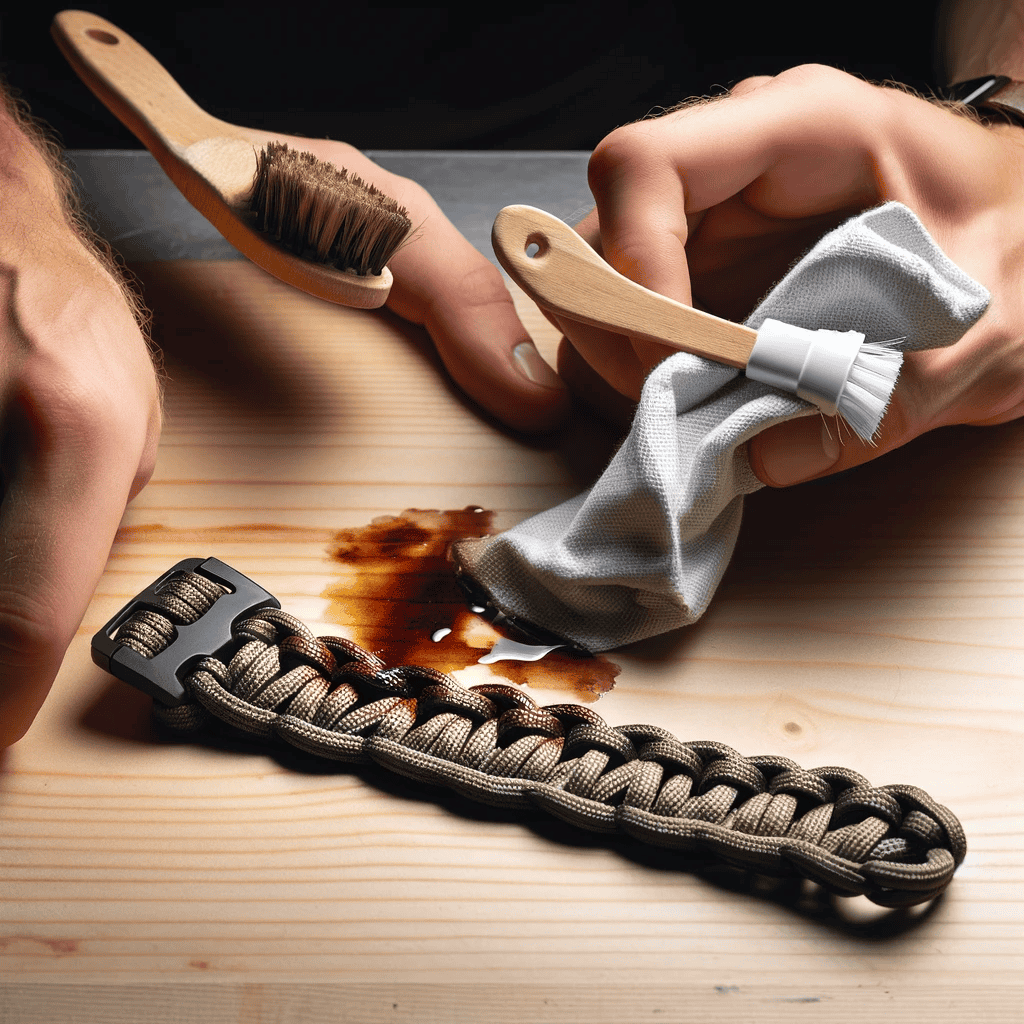
Identifying the Stain Type
First, identify the type of stain you’re dealing with. Organic stains like food or mud require different treatment than oil-based stains or ink. Stain Identification Guide
Gentle Scrubbing
After pre-treating, use a soft brush to gently scrub the stain. This helps to lift the stain from the nylon fibers. Be careful not to scrub too hard, as this can fray the material. Effective Scrubbing Techniques
Rinsing Under Cold Water
Rinse the bracelet under cold water to wash away the stain and any cleaning agents. Cold water is generally safer for paracord as it prevents color bleeding and material damage.
Using Vinegar for Organic Stains
White vinegar is effective against organic stains like grass or food. Mix one part vinegar with two parts water and apply it to the stain. After soaking for a few minutes, wash the bracelet as normal.
Drying and Storage Post-Cleaning for Paracord Bracelets
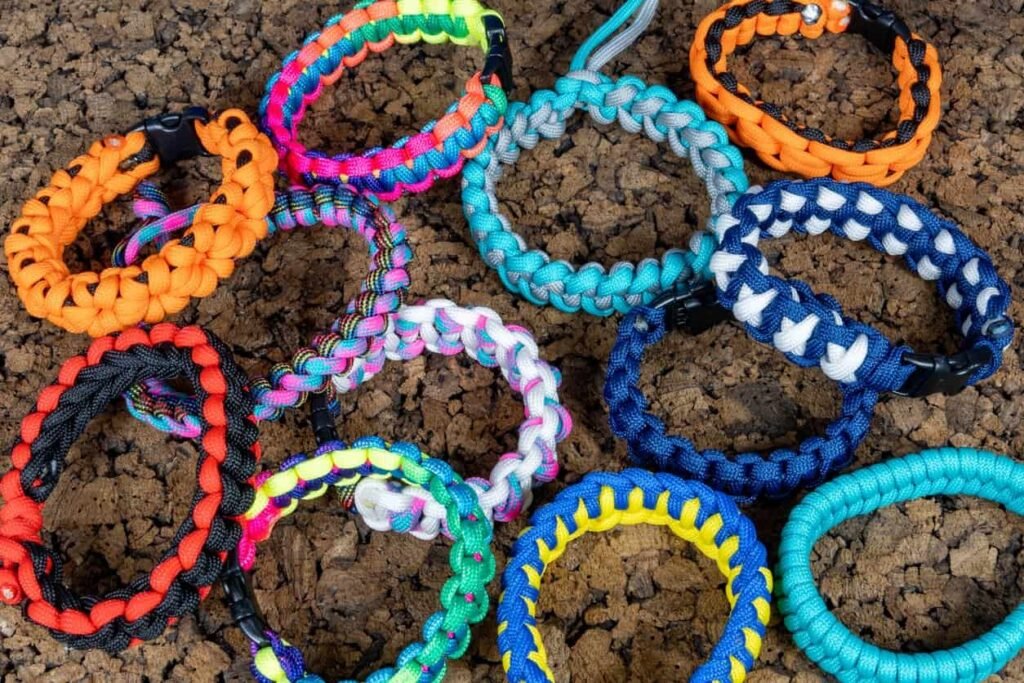
Patting Down Excess Water
Before laying the bracelet out to dry, gently pat it with a towel to remove excess water. This speeds up the drying process and prevents water from pooling in any crevices, which could lead to mildew.
Ensuring Complete Drying
Ensure that the bracelet is completely dry before storage. Nylon can hold moisture, and storing the bracelet while it is still damp may result in mildew or unpleasant odors. Complete Drying Checklist
Avoiding Direct Sunlight During Storage
Store the bracelet away from direct sunlight to prevent color fading. Sun exposure can also degrade the nylon over time, reducing the bracelet’s strength and flexibility. Sunlight Protection for Paracord
Maintaining Shape During Storage
To maintain the shape of the bracelet, consider storing it wrapped around a cylindrical object, like a bracelet mandrel or a small bottle. This is especially useful for intricately woven or larger bracelets.
Regular Inspection
Regularly inspect stored bracelets for any signs of damage or wear, especially if they are stored for extended periods. This proactive approach can help you address any issues before they become major problems. Paracord Bracelet Inspection Guide
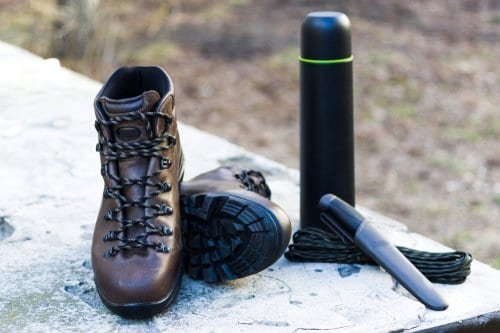
FAQ
Q1: Can I machine wash my paracord bracelet?
A: It’s generally recommended to hand wash paracord bracelets to avoid potential damage from the agitation of a washing machine. If you do use a machine, place the bracelet in a mesh laundry bag and use a gentle cycle with cold water.
Q2: How often should I clean my paracord bracelet?
A: Clean your paracord bracelet as needed, depending on your level of use and exposure to dirt and elements. Regular wearers might find a monthly cleaning sufficient, while those using it in outdoor or dirty environments may need to clean it more frequently.
Q3: Will saltwater damage my paracord bracelet?
A: Paracord is generally durable and resistant to saltwater. However, prolonged exposure can lead to fading and weakening of the fibers. Rinse the bracelet with fresh water after exposure to saltwater and dry it thoroughly.
Q4: Can I use bleach to clean my paracord bracelet?
A: Avoid using bleach on paracord bracelets, as it can weaken the nylon fibers and cause discoloration. Stick to mild soap or a specialized paracord cleaner for safe cleaning.
Q5: How do I remove oil or grease stains from my paracord bracelet?
A: For oil or grease stains, apply a small amount of dish soap or degreaser to the affected area, gently rub it in, and rinse thoroughly. Dish soap is effective in breaking down oils and grease.
Q6: How can I dry my paracord bracelet quickly?
A: To quickly dry your paracord bracelet, pat it dry with a towel and lay it flat in a well-ventilated area. Avoid direct heat sources like hairdryers or radiators, as they can damage the nylon.
Q7: Is it safe to dry a paracord bracelet in the sun?
A: While air drying in sunlight is okay for short periods, prolonged sun exposure can fade the colors and weaken the paracord. It’s better to dry it in a shaded, well-ventilated area.
Conclusion
In summary, properly cleaning and maintaining your paracord bracelet is key to preserving its strength, color, and functionality. Whether it’s used as a fashion statement or a survival tool, regular and careful cleaning will keep your bracelet in top condition. By following the guidelines outlined in this article, from hand washing to air drying, you can ensure that your paracord bracelet remains a durable and reliable accessory for all your adventures, big and small.

